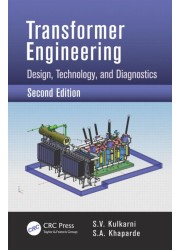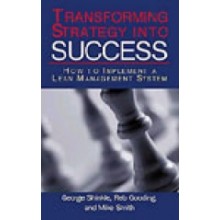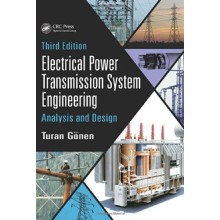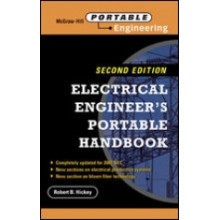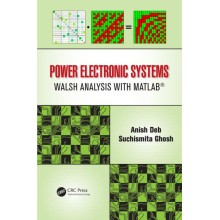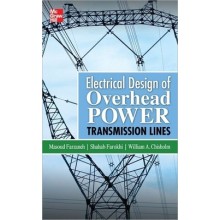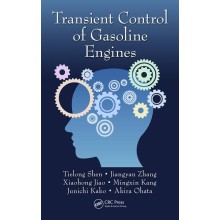Transformer Engineering: Design, Technology, and Diagnostics, Second Edition
ISBN: 9781439853771
Author: S.V. Kulkarni, S.A. Khaparde
Dispatch Time: 15 - 30 Days
Quantity:
-
Add to Compare
Transformer Engineering: Design, Technology, and Diagnostics, Second Edition helps you design better transformers, apply advanced numerical field computations more effectively, and tackle operational and maintenance issues. Building on the bestselling Transformer Engineering: Design and Practice, this greatly expanded second edition also emphasizes diagnostic aspects and transformer-system interactions.
Table of Contents
Transformer Fundamentals
Perspective
Applications and Types of Transformers
Principles and the Equivalent Circuit
Representation of a Transformer in Power System
Open-Circuit and Short-Circuit Tests
Voltage Regulation and Efficiency
Parallel Operation of Transformers
References
Magnetic Characteristics
Construction
Hysteresis, Eddy, and Anomalous Losses
Excitation Characteristics
Over-Excitation Performance
No-Load Loss Test
Impact of Manufacturing Processes
Inrush Current
Influence of the Core Construction and Winding Connections on No-Load Harmonic Phenomenon
Transformer Noise
Rotational Core Losses
References
Impedance Characteristics
Reactance Calculation
Different Approaches for Reactance Calculation
Analytical Methods
Numerical Method for Reactance Calculation
Impedance Characteristics of Three-Winding Transformers
Reactance Calculation for Zigzag Transformers
Zero-Sequence Reactances
Stabilizing Tertiary Winding
References
Eddy Currents and Winding Stray Losses
Field Equations
Poynting Vector
Eddy Current and Hysteresis Losses
Effect of Saturation
Eddy Losses in Transformer Windings
Circulating Current Loss in Transformer Windings
References
Stray Losses in Structural Components
Factors Influencing Stray Losses
Overview of Methods for Stray Loss Estimation
Core Edge Loss
Stray Loss in Frames
Stray Loss in Flitch Plates
Stray Loss in Tank
Stray Loss in Bushing Mounting Plates
Evaluation of Stray Loss Due to High Current Leads
Measures for Stray Loss Control
Methods for Experimental Verification
Estimation of Stray Losses in Overexcitation Condition
Load Loss Measurement
References
Short-Circuit Stresses and Strength
Short-Circuit Currents
Thermal Capability During a Short-Circuit
Short-Circuit Forces
Dynamic Behavior under Short-Circuits
Failure Modes Due to Radial Forces
Failure Modes Due to Axial Forces
Failure Modes Due to Interactive (Combined Axial and Radial) Forces
Effect of Prestress
Short-Circuit Test
Effect of Inrush Current
Split-Winding Transformers
Short-Circuit Withstand
Calculation of Electrodynamic Force between Parallel Conductors
Design of Clamping Structures
References
Surge Phenomena in Transformers
Initial Voltage Distribution
Ground Capacitance Calculations
Capacitance of Windings
Inductance Calculation
Standing Waves and Traveling Waves
Methods for Analysis of Impulse Distribution
Computation of Impulse Voltage Distribution Using State Variable Method
Winding Design for Reducing Internal Overvoltages
References
Insulation Design
Calculation of Stresses for Simple Configurations
Field Computations
Factors Affecting Insulation Strength
Test Methods and Design Insulation Level (DIL)
Insulation between Two Windings
Internal Insulation
Design of End Insulation
High-Voltage Lead Clearances
Statistical Analysis for Optimization and Quality Enhancement
References
Cooling Systems
Modes of Heat Transfer
Cooling Arrangements
Dissipation of Core Heat
Dissipation of Winding Heat
Aging and Life Expectancy
Direct Hot Spot Measurement
Static Electrification Phenomenon
Recent Trends in Computations
References
Structural Design
Importance of Structural Design
Different Types of Loads and Tests
Classification of Transformer Tanks
Tank Design
Methods of Analysis
Overpressure Phenomenon in Transformers
Seismic Analysis
Transformer Noise: Characteristics and Reduction
Transport Vibrations and Shocks
References
Special Transformers
Rectifier Transformers
Converter Transformers for HVDC
Furnace Transformers
Phase Shifting Transformers
References
Electromagnetic Fields in Transformers: Theory and Computations – New!
Perspective
Basics of Electromagnetic Fields Relevant to Transformer Engineering
Potential Formulations
Finite Element Method
FEM Formulations
Coupled Fields in Transformers
Computation of Performance Parameters
References
Transformer-System Interactions and Modeling – New!
Power Flow Analysis with Transformers
Harmonic Studies
Ferroresonance
Arc Furnace Application
Geomagnetic Disturbances
Sympathetic Inrush Phenomenon
Internal Resonances Due to System Transients
Very Fast Transient Overvoltages
Transients in Distribution Transformers
Low,-Mid- and High-Frequency Models of Transformers
References
Monitoring and Diagnostics – New!
Conventional Tests
Dissolved Gas Analysis
Partial Discharge Diagnostics
Degree of Polymerization and Furan Analysis
Time Domain Dielectric Response Methods
Frequency Domain Dielectric Response Method
Detection of Winding Displacements
Accessories
Other Diagnostic Tests/Instruments
Life Assessment and Refurbishment
References
Recent Trends in Transformer Technology
Magnetic Circuit
Windings
New Insulating Liquids
Advanced Computations
Transformers for Renewable Energy Applications
Applications of Power Electronics
Other Technologies
Trends in Monitoring and Diagnostics
References
Write a review
Your Name:Your Review: Note: HTML is not translated!
Rating: Bad Good
Enter the code in the box below:
Copyright © 2014 Engineering Standards Bureau. All Rights Reserved.
Developed By Zoom Into Web


